Pontevedra
Pontevedra (Galician: [ˌpontɪˈβɛðɾɐ], Spanish: [ponteˈβeðɾa]) is a Spanish city in the north-west of the Iberian Peninsula. It is the capital of both the Comarca (County) and Province of Pontevedra, and of the Rias Baixas in Galicia. It is also the capital of its own municipality which is, in fact, often considered as an extension of the actual city.
Pontevedra | |
|---|---|
City | |
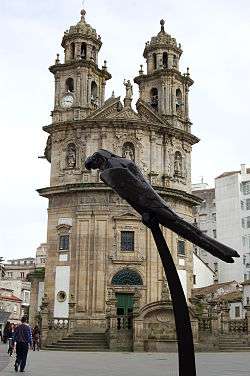 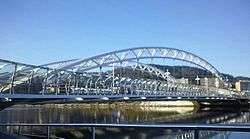 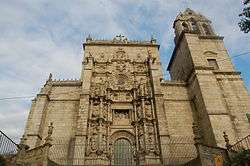 Pontevedra city | |
 Flag 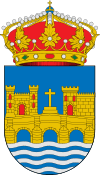 Coat of arms | |
| Motto(s): Pontevedra boa vila (The good town of Pontevedra) | |
 Location of the municipality of Pontevedra within Galicia | |
 Pontevedra Location of Pontevedra in Spain | |
| Coordinates: 42.433619°N 8.648053°W | |
| Country | |
| Region | |
| Province | Pontevedra |
| County | Pontevedra |
| Parishes | Alba, Bora, O Burgo, Campañó, Campolongo, A Canicouva, Cerponzóns, Lérez, Lourizán, Marcón, Monteporreiro, Mourente, Ponte Sampaio, San Bartolomé de Pontevedra, Santa María de Pontevedra, A Virxe do Camiño de Pontevedra, Salcedo, Santa María de Xeve, Tomeza, Verducido, Xeve |
| Government | |
| • Type | Mayor–council |
| • Body | Concello de Pontevedra |
| • Mayor | Miguel Anxo Fernández Lores (BNG) |
| Area | |
| • Total | 118.3 km2 (45.68 sq mi) |
| Elevation | 20 m (70 ft) |
| Population (2018)[1] | |
| • Total | 82,802 |
| • Density | 701.0/km2 (1,815.5/sq mi) |
| Demonym(s) | pontevedrés (m), pontevedresa (f) lerense teucrino (m) teucrina (f) |
| Time zone | CET (GMT +1) |
| • Summer (DST) | CEST (GMT +2) |
| Postcode | 36001-36164 |
| Area code(s) | +34 986 / 886 |
| ISO 3166-2 | ES-PO |
| Website | City of Pontevedra |
The city is best known for its urban planning, pedestrianisation and the charm of its historic centre. In recent years, it has been awarded several international awards for its urban quality and quality of life, accessibility and urban mobility policy,[2] like the international European INTERMODES Urban Mobility Award in 2013,[3] the 2014 Dubai International Best Practices Award for Sustainable Development awarded by UN-Habitat in partnership with Dubai Municipality[4] and the "Excellence Prize" of the Center for Active Design in New York City in 2015,[5] among others. Pontevedra's car free center helped transform it into one of the most accessible European cities, leading to various European and American studies on its exemplary urban planning been carried out in recent years.[6]
Surrounded by hills, the city is located on the edge of an estuary at the mouth of the river Lérez by the sea, at the bottom of the Ría de Pontevedra, in the heart of the Rías Baixas. An economic centre and tourist destination, with a population of 83,029, it is at the head of an urban area around its Ria of more than 200,000 inhabitants comprising the municipalities of Poio, Marín, Sanxenxo, Bueu, Vilaboa, Cotobade, Ponte Caldelas, Barro and Soutomaior.
Pontevedra is the second city in Galicia for its rich heritage, only after Santiago de Compostela. A city of art and history, the city is known as "The Good City" or "The City of the Lérez". The city is also an important stopover on the Portuguese Way path of the Camino de Santiago that bears witness to the circular church of the Pilgrim's Virgin with a floor plan in the shape of a scallop shell and the scallop shells sculpted in the arches of the medieval Burgo bridge.
The city is marked by a strong presence of administrative and justice services. Pontevedra is the seat of the Diputación Provincial (equivalent to the General Provincial Council), the prefecture (Subdelegación del Gobierno) of the province of Pontevedra as well as the Palace of Justice and the provincial district court (Audiencia Provincial), the provincial police station and the provincial administrative offices.
History
Name
The name of the city is likely a Latin composite of pons, pontis (bridge) and veter, vetera, veterum (old, long established). In Galicia, Latin pons, a masculine word, became feminine, hence Vulgar Latin Ponte Vetera,[7] which became by the 13th century the modern Galician language toponymy Pontevedra, "the old bridge", in reference to an old Roman bridge across the Lérez River which had been located near the 12th century Burgo Bridge that remains in place today.
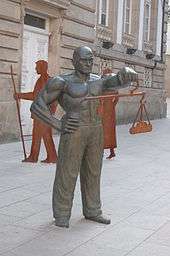
However, at present there is no consensus among historians on the name of the city. Traditionally, it has always been believed that the name of the city derives from the Latin pontem veteram, which means old bridge and refers to the first bridge that the Romans built to cross the River Lérez and the Ria de Pontevedra. However, in ancient Latin, ponto (pontus) meant sea and vedra meant green. Its name could therefore be due to the peculiar greenness of the sea caused by the seaweed tides, being the meaning of the name of the city "that of the green sea". Archived 26 January 2020 at rtve.es [Error: unknown archive URL]
Pre-history and antiquity
A local legend relates the foundation of Pontevedra to Teucer, hero of the Trojan War, a legend which was reinforced with the suspicion that Greek traders might have arrived to the Rias Baixas area in ancient times.[8] However, historians and archaeologists tend to agree that the initial settlement was probably formed during the integration of Gallaecia (old Galicia) into the Roman Empire (circa 1st century BC)(Reference is required). The current name of the city is a Latin composite, derived from Pons/Pontis (bridge) and Veteris/Vetera (old), hence Ponte(m)Vetera(m), and thence Galician language Ponte-Vedra, "the old bridge", in reference to the old Roman bridge across Lérez River. Well-connected since Roman times, Pontevedra consolidated itself as an intermediate town during the Suebic period (circa 5th-6th century AD).

Medieval and early modern
During the 12th century Pontevedra rose as an important commercial centre; it reached its zenith in the 15th century as a trade and communications hub. Pontevedra was the main Galician urban centre. In fact, Pontevedra has the second largest "old town" in Galicia, only after Santiago de Compostela. Pontevedra was on the route of the Way of Saint James, namely its southern or "Portuguese" branch. The "Igrexa da Virxe Peregrina" (Church of the Pilgrims), with its distinctive scallop-shaped floor plan, is a destination for tourists and pilgrims.
In the 16th century it still was a commercial city, with an increase in fishing. At that time, Pontevedra was the largest Galician port, as it was a secure port open to the sea. One of Christopher Columbus' ships, the carrack Santa Maria, originally named La Gallega ("The Galician"), was built in Pontevedra.[9][10] It was in centuries later that the sedimentation caused by river Lérez gradually rendered the harbour unsuitable for large-scale navigation. The end of the 16th century marked the beginning of the decline of the city, a decline which had already started for the rest of Galicia from the end of the 15th century.
Late modern
The situation would worsen during the 17th and 18th centuries. The port drastically reduced its activity due to the mentioned geographical causes. Furthermore, political decisions and dynastic conflicts provoked a general decay in trade, thus resulting in the depopulation of the city; the population was reduced in half during that time, also affected by epidemics.[11]
In the beginning of the 19th century Pontevedra was little more than a small backward town. Fishing, arts and crafts kept the economy going. Yet, with the establishment of new provincial divisions in 1833 Pontevedra suddenly saw itself transformed into a provincial capital. Pontevedra then grew and slowly became an administrative centre. The introduction of the railway also reconnected the city with the rest of the country, after having lost its harbour. All in all, Pontevedra sees in this century a cultural, economic and urban revival. It is in Pontevedra when, in 1853, Xoán Manuel Pintos publishes the first book in modern Galician, "A gaita gallega".
20th and 21st centuries
Pontevedra entered the 20th century with great prospects. The city was at the heart of Galician culture and politics. Galicianists - such as Alexandre Bóveda and Castelao - took up residence in the city, where in 1931 they founded the Partido Galeguista ("Galicianist Party"), the origin of contemporary Galician nationalism. However, the Spanish Civil War (1936–1939) and subsequent Francoist dictatorship (1939–1975) suddenly ended Pontevedra's progression. Political repression and economic hardships forced many to emigrate. The recovery of the local economy only partially began in the 1960s, with the introduction of some industrial activity. However, these very activities would later cause serious environmental and health concerns, forcing the eventual closure of some of them.
With the end of the dictatorship in 1975 the construction sector also developed. Improvements in the communications network during the 1980s and 1990s helped Pontevedra to regain weight in the Rias Baixas region, acting again as a trade hub and focusing on its administrative functions as provincial capital. The introduction of university studies in the city during the 1990s contributed further to the growth of the city. Since 1999 Pontevedra has seen intense urban renewal and cultural revival, positively influencing the local economy. In the 21st century the city of Pontevedra has undergone both a cultural renaissance and an urban transformation, taking in the pedestrianisation of the city centre, extension of cycle lanes, recovery of the historical and natural heritage, rehabilitation of buildings and public spaces, and an increase in green areas and pedestrian walkways. Unlike the other six large cities of Galicia, which have lost inhabitants to neighboring municipalities, Pontevedra's population is currently increasing. It has become one of the most accessible cities for disabled people, receiving a national prize for this in 2006, along with the international European INTERMODES Urban Mobility Award in 2013, the 2014 Dubai International Best Practices Award for Sustainable Development awarded by UN-Habitat in partnership with Dubai Municipality and the Award of the Center of Active Design in New York in 2015. Pontevedra's model for responsible mobility is currently seen as an international reference.[12][13][14][15]
Geography
Physical
Location and subdivisions


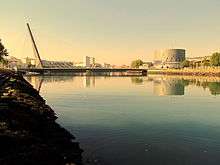
The municipality of Pontevedra is located between 42°20' and 42°30' north and 8°33' and 8°41' west, in the southwestern Galician coast, an area popularly known as Rias Baixas. The municipality covers 118.3 km² and is about 20 km wide from north to south.
The city sits at the end of the ria that bears its name, occupying the valleys of the Lérez and Tomeza rivers. It extends southwards to the mouth of river Verdugo in Ponte Sampaio. It is surrounded by four mountainous regions divided by two faults, one stretching north–south and one from northeast to southwest.
To the north it borders the municipalities of Barro, Moraña and Campo Lameiro; to the east, Cotobade and Ponte Caldelas; to the south, Soutomaior, Vilaboa and Marín, and to the west, Poio and the ria, leading to the Atlantic Ocean.
The main parroquias (parishes) of Pontevedra are: Alba, Bora, Campañó, A Canicouva, Cerponzóns, Estribela, Lérez, Lourizán, Marcón, Mourente, Ponte Sampaio, Salcedo, San Xosé, Santa María de Xeve, Tomeza, Verducido, Xeve.
The neighbourhoods or main areas of Pontevedra are: O Burgo, Monteporreiro, Campolongo, Mollabao, A Seca, Salgueiriños, A Parda, Gorgullón. The residential area of A Caeira, although officially located in the municipality of Poio, is often considered as just another neighbourhood of Pontevedra since the vast majority of the residents work in Pontevedra and relate to the city.
Climate
Pontevedra has a humid oceanic climate (Köppen Cfb). The average temperature is 15 °C (59 °F), with a daily average of 9.5 °C (49.1 °F) in January and 20.5 °C (68.9 °F) in July. These are unusually mild for a city so far north, and are due to Pontevedra's proximity to the sea and to the moderating effect of the ria. Yet, like all the Galician coast, Pontevedra is subject to occasional Atlantic storms in winter. These are characterised by a quick drop in temperature, rain and gales. With eleven of the twelve months above 10 °C (50 °F) Pontevedra is in the maritime subtropical climate zone under the Trewartha climate classification, a classification it falls short of under the Köppen classification due to the cool summer nights.
Overall Pontevedra, as Galicia, is rainy, especially at the end of autumn and winter, with an annual average precipitation of 1,700 to 1,900 millimetres (66.9 to 74.8 in), and around 134 rainy days per year. Summer is drier, generally speaking, but the odd heavy rainfall does happen even then.[16]
| Climate data for Pontevedra 108m (1981-2010) | |||||||||||||
|---|---|---|---|---|---|---|---|---|---|---|---|---|---|
| Month | Jan | Feb | Mar | Apr | May | Jun | Jul | Aug | Sep | Oct | Nov | Dec | Year |
| Record high °C (°F) | 22.5 (72.5) |
23.4 (74.1) |
28.4 (83.1) |
31.3 (88.3) |
34.0 (93.2) |
38.0 (100.4) |
39.5 (103.1) |
38.2 (100.8) |
36.6 (97.9) |
32.2 (90.0) |
25.6 (78.1) |
23.4 (74.1) |
39.5 (103.1) |
| Average high °C (°F) | 12.9 (55.2) |
14.2 (57.6) |
16.9 (62.4) |
17.6 (63.7) |
20.6 (69.1) |
23.8 (74.8) |
25.9 (78.6) |
26.0 (78.8) |
23.7 (74.7) |
19.6 (67.3) |
15.4 (59.7) |
13.4 (56.1) |
19.2 (66.6) |
| Daily mean °C (°F) | 9.6 (49.3) |
10.4 (50.7) |
12.4 (54.3) |
13.0 (55.4) |
15.8 (60.4) |
18.6 (65.5) |
20.4 (68.7) |
20.6 (69.1) |
18.8 (65.8) |
15.7 (60.3) |
12.1 (53.8) |
10.3 (50.5) |
14.8 (58.6) |
| Average low °C (°F) | 6.3 (43.3) |
6.5 (43.7) |
7.8 (46.0) |
8.4 (47.1) |
10.9 (51.6) |
13.4 (56.1) |
14.9 (58.8) |
15.2 (59.4) |
13.8 (56.8) |
11.7 (53.1) |
8.7 (47.7) |
7.1 (44.8) |
10.4 (50.7) |
| Record low °C (°F) | −3.6 (25.5) |
−1.7 (28.9) |
−2.0 (28.4) |
0.6 (33.1) |
4.2 (39.6) |
7.0 (44.6) |
9.2 (48.6) |
9.8 (49.6) |
7.2 (45.0) |
4.2 (39.6) |
0.0 (32.0) |
−1.5 (29.3) |
−3.6 (25.5) |
| Average rainfall mm (inches) | 178 (7.0) |
133 (5.2) |
120 (4.7) |
143 (5.6) |
118 (4.6) |
64 (2.5) |
44 (1.7) |
56 (2.2) |
95 (3.7) |
224 (8.8) |
222 (8.7) |
216 (8.5) |
1,613 (63.5) |
| Average precipitation days (≥ 1 mm) | 14 | 11 | 11 | 14 | 12 | 7 | 5 | 6 | 8 | 14 | 14 | 14 | 131 |
| Mean monthly sunshine hours | 103 | 123 | 181 | 203 | 239 | 262 | 294 | 279 | 224 | 145 | 104 | 91 | 2,248 |
| Source: Agencia Estatal de Meteorología[17] | |||||||||||||
Human
Population
The municipality of Pontevedra is composed of the city of Pontevedra and fifteen rural parishes in close proximity, with a total population of 82,946 (as of 2014).[18] This results in a relative high density of population of 710.1 inhabitants per square kilometre. More than two-thirds of the population live in the city, and less than one-third in the rural parishes.
The population of Pontevedra is aging, with generational replacement is not necessarily assured, although the city's population has been gradually growing in recent years. Broken down by age, 15.93% of the population were senior citizens, 69% between 15 and 65 years, and just 15.01% under the 15 years of age. The natality rate (9.8‰) is only +1.8 over the mortality rate (8‰). The migrational balance is slightly positive (+350 people in 2006).[18] According to the local authorities Pontevedra is, since 1999, the fastest growing Galician city, with an average of +1000 more inhabitants per year.[19]
| Year | Population |
|---|---|
| 1900 | 22,330 |
| 1930 | 30,821 |
| 1950 | 43,221 |
| 1981 | 64,184 |
| 2004 | 78,715 |
| 2007 | 80,202 |
| 2009 | 81,576 |
| 2012 | 82,684 |
| 2019 | 83,029 |
According to the 2001 census, 29.6% of the population have Galician as their mother tongue, where 32.1% speak it "often". The remaining 38.3% speak Castilian as their native language or speak mostly in Castilian[20]
Urban planning and living environment
Pontevedra has a pedestrian city centre (which includes the old town and the city centre or first urban expansion area) which, together with parks such as Las Palmeras (the Palms) and squares, make the city very pleasant to walk in and give it a high quality of life.[21][22]

An island on the Lérez opposite a remarkable cable-stayed bridge dating from 1995 (the Pont of Tirantes, the Strap Bridge) and next to the modern Congress Hall shelters the city's green lung, the famous sculpture island park.[23] It is a space where international artists such as Robert Morris, Ulrich Rückriem, Anne and Patrick Poirier, Giovanni Anselmo, Richard Long, Ian Hamilton Finlay or Jenny Holzer have left their works.
Another large park, the Junquera of Alba, is located near the Burgo district, in front of the "bowstring" bridge of Las Corrientess, inaugurated in 2012.
Pedestrianization
The capital of the province of Pontevedra has become one of the most pedestrianised cities in Spain over the last fifteen years. The old city and much of the city centre are pedestrianized, so that in these neighbourhoods, motorized transport is limited to residents and services.
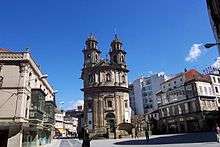
In 1999 Pontevedra began its transformation process by pedestrianizing its old town. In the following years, the city centre and some other streets on the outskirts of Pontevedra were pedestrianised too. In 2010, Pontevedra was the first provincial capital in Spain to reduce the maximum speed in the city centre to 30 kilometres per hour and in 2019 to 10 kilometres per hour in the city centre.
In Pontevedra, the Metrominuto pedestrian plan was created for urban mobility, which with the urban transformation of the city has won many national and international awards such as the international European INTERMODES Urban Mobility Award in 2013 and the 2014 Dubai International Best Practices Award for Sustainable Development awarded by UN-Habitat in partnership with Dubai Municipality. The Metrominuto is a map based on the aesthetics of metro maps, which marks the pedestrian distances between the most important points of the city and the time it takes to travel them. The Metrominuto has been used as a model in other European cities such as Toulouse in France, Florence, Ferrara Modena or Cagliari in Italy, Poznan in Poland or the Angels' district in London. In Spain, it has inspired other cities such Zaragoza, Seville, Cadiz, Salamanca, Granada, Jerez de la Frontera, A Coruña or Pamplona. As a result, 65% of trips in the city centre are made on foot. Pontevedra was recognized in 2016 as one of the 15 best cycling cities in the world. The urban model of the city of Pontevedra follows the models of other European cities such as Amsterdam, Bruges or Copenhagen.
The urban transformation of Pontevedra and measures to reduce motorized traffic in the city centre have reduced by 65% the emissions of CO
2 from fossil fuels in the capital over the last decade and have been reported by foreign and French television channels such as France 2,[24] France 3, Canal+ or TF1 and the Swiss channel Radio Télévision Suisse RTS and other foreign televisions like MBC TV in South Korea, the Canadian Broadcasting Corporation in Canada or Seven Network in Australia.
Transport
Pontevedra is well connected by road and rail. It sits on the A Coruña-Tui railway and motorway corridor. Pontevedra is located between the Galician capital Santiago de Compostela (58 km to the north) and the largest Galician municipality, Vigo (30 km to the south). Pontevedra city itself does not have an airport in its municipality but the city is relatively close to the airports of Lavacolla to the north (in the municipality of Santiago de Compostela) and Peinador to the south (in the municipalities of Redondela, Mos and Vigo). A good network of roads and motorways efficiently connects Pontevedra with the other Galician cities, and also with Portugal (55 km to the south), and inland (100 km to the eastern city of Ourense). Regular bus lines link Pontevedra with other Galician cities and towns, as well as with Madrid, Porto and Lisbon (among others).
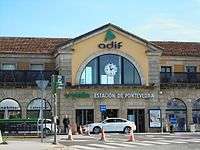
The AVE high-speed train (in Spanish Tren de alta velocidad, or TAV) reaches Pontevedra and the city is a stop in the "Atlantic Line", running from the northern Galician city of A Coruña to Lisbon (Portugal).[25][26][27] Likewise, Pontevedra will benefit from the high-speed train connecting Galicia and central Spain. That Galician connection will be fully operational in 2018.[28]
Despite the fact that Pontevedra was once the main Galician port, at present the tiny Pontevedra harbour is only used for recreational purposes, not for cargo or passenger transportation. Neighbouring Marín is a major military and commercial harbour 7 km away.
Landmarks
Thanks to a remarkable old town, the surrounding landscape and its former medieval port Pontevedra has been defined as a "charming city"[29] and "an authentic Galician city". Tourist attractions include many religious and civil buildings as well as picturesque medieval squares.
Religious heritage
- Baroque church of the Pilgrim Virgin. The major symbol of the city, it is on the Place of the Pilgrim Virgin. Built on a semi-circular scallop plan, it is the only rounded scallop-shaped church in Spain.
- Gothic-Renaissance Basilica of St. Mary Major. Built by the powerful sailors guild. It has a remarkable flattened facade.

- Gothic church of St. Francis overlooking the Herrería Square. It is one of the mendicant-style churches in Galicia. Its plan is a Latin cross, with a single nave and a chevet with three polygonal apses. The church houses the tomb of the admiral and poet Payo Gómez Chariño, which dates from the 13th century.
- Ruins of the Gothic church of St. Dominic, having belonged to the Dominican order, only the chevet with five polygonal chapels remains. Today they belong to the Pontevedra Museum.
- Baroque church of St. Bartholomew (Italian baroque).
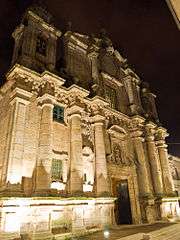
- Convent and Romanesque-Gothic church of St. Clare.
- Shrine of the Apparitions. Where the Virgin of Fatima appeared at Sister Mary Lucia of Jesus and the Immaculate Heart of Fatima.
- Chapel of the Nazareno (S.XIV)
- Chapel of Souls (Neo-Gothic, S.XIX).
- Chapel Saint-Rock.
- Saint-Francis Convent.
- College of the Society of Jesus (Italian Baroque).
- Monastery of Saint-Saviour of Lérez, a Baroque reanimation on a picturesque site. This former Benedictine monastery has a church (from the 18th century) whose facade is flanked by two towers. Adjacent to the church is one of the galleries of the former Renaissance cloister of the 16th century.
- Monastery of St. John of Poio.
Civil Heritage
- House of the Bells, Gothic, from the 15th century, with a heron in the coat of arms, Don Filiberto Street.
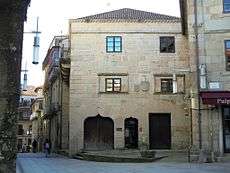
- House of the Vaamonde, Renaissance, Amargura stret, 16th century.
- Old Mail House, late Gothic, in García de la Riega Square.
- Remains of the medieval ramparts.
- Medieval bridge of the Bourg. The bridge that gave the name to the city.
- Barón Palace, Renaissance building from the 16th century, with a crenellated tower, now converted into a National Tourism Parador.
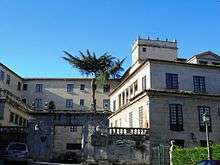
- Palace of the Gago and Montenegro (16th century), in the square of Teucer, with a magnificent coat of arms in granite.
- House of Faces, with Renaissance busts on the facade, on the Estrella Square.
- Mugartegui Palace, baroque, from the 18th century, on Mugartegui Square or the Quarry Square.
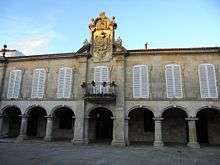
- Palace of García Flórez, baroque, from the 18th century, Sarmiento street, with a magnificent granite coat of arms.
- Palace of the Marquis of Aranda, baroque, from the 18th century to the crenellated tower at the corner of the square of Teucer.
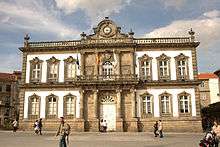
- House of the Barbeito and Padrón, baroque with Renaissance busts on the façade, from the 18th century, Real Street.
- Main Theatre, neoclassical.
- City hall, 19th century of Parisian inspiration.
- The Palace of the Provincial Council of the 19th century, eclectic.
- Mansion house of the Mendozas, eclectic, on the Saint-Mary avenue, (end of the 19th century).
- House of the Fonseca, neoclassical, on Paseo of Colón. Its facade is inspired by the church of the Paris Madeleine, (end of the 19th century).
- Valle-Inclán High School (art nouveau), beginning of the 20th century on Gran Vía de Montero Ríos.
- Central Post Office building (art nouveau), beginning of the 20th century, Olive street.
- Lourizán Palace (art nouveau), (end of the 19th century).
- Modern Coffee (art nouveau), on San José square.
- Villa Pilar" private mansion (art nouveau), Riestra street.
- Faculty of Fine Arts, end of the 19th century)
- Bank of Spain, Rue Michelena (end of the 19th century).
- Former sailors' quarter of "A Moureira". (popular architecture), on Corbaceiras Avenue.
- Monument to the Heroes of Puente Sampayo, in the Spain Square, beginning of the 20th century
- Tie-rod bridge (Strap bridge), cable-stayed bridge, end of the 20th century
- Bridge of Currents, bowstring bridge
- Congress Hall Palace
Picturesque medieval squares
The medieval squares of the old town of Pontevedra and those of its first urban expansion stand out as small rooms with regular and geometric proportions. Many of them evoke with their trade names the activities that took place centuries ago: Plaza of firewood, vegetables, the stone quarry, the blacksmith's, the quay...
Plaza de la Herrería
Blacksmith's square is the main square of the city; it is the most popular because of the daily crowds. With arches in two of its ends, with the gardens of the Plaza of Orense and the Herrería fountain at the corner of the church and convent of St. Francis. It is lined with camellias typical of the Rias Baixas. It owes its name to the blacksmiths who, in the 15th century, tempered the iron in the ovens and forges of its arcades for the weapons and paving stones that the Catholic Monarchs had asked them to manufacture. It was the place where the Feira Franca was held, granted to the city by King Henry IV. Here you will find the historic Carabela coffee shop, and other traditional coffees such as Savoy and San Francisco.
Plaza de la Peregrina
In the heart of the pedestrian centre of Pontevedra, the Pilgrim Virgin Square is the city's main meeting point. It is presided over by the Church of the Pilgrim Virgin and was located outside the walls, very close to the Trabancas gate of the old Pontevedra wall. This is where the pillory where the prisoners were executed was located.
Teucer square
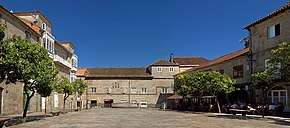
With perfect geometric dimensions and framed by orange trees, it is surrounded by noble buildings, with the 18th century Gago and Montenegro Palace standing out on the north side, where the great coat of arms of 1716 is to be seen on the façade. On the east side, overlooking Royal Street, there is a stone fountain with night lighting.
Plaza de la Leña
The Firewood Square is the most representative and picturesque typical Galician square in Galicia. With a calvary in its centre and popular houses with arcades on one side and the Baroque houses of the Pontevedra Museum on the other. It owes its name to the firewood that was sold here in the past to heat Pontevedra's kitchens.
Plaza de la Verdura
Regularly proportioned, on the Vegetables square there are houses with coats of arms and a 19th-century forge fountain. This is where the House of Light is located, which commemorates the fact that Pontevedra was the first Galician city to have electricity in the 19th century. Today it is the headquarters of the Pontevedra Tourist Office. The square is very lively, to which the atmosphere of the many Galician taverns and tapas bars contributes.
Praza da Pedreira
The Stone Quarry square is so called because of the stone-cutting activities developed here by stonemasons for the city's works and constructions. Also called Plaza of Mugartegui, because of the baroque mansion in its center.
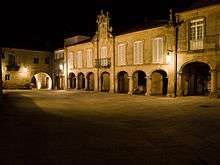
Plaza de Méndez Núñez
In the centre of the old town, there is the 15th century house with a stone coat of arms (showing the arms of the Lemos, Taboada and Bugarín) of Cru and Montenegro, which crosses Don Gonzalo Street with its pointed arch. In its centre is a bronze statue of Valle-Inclán, the work of the sculptor César Lombera. The sculpture is in this square because it was there that the writer used to meet other intellectuals when he lived in Pontevedra.

Plaza de Curros Enríquez
Triangular square where you can admire the French attic of the house on the north side and one of the 19th century forge fountains.

Plaza del Muelle
The Quay Square is the name given to the docks of the medieval port of Pontevedra. There is a stone fountain in its centre and a 1930s house on the south side which now belongs to the official school of quantity surveyors.
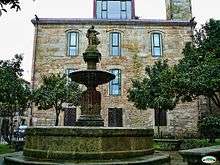
Plaza de las Cinco Calles
It is so called because it is where the two parts of Isabel II Street and Baron, Charino and San Nicolás Streets meet. Filled with tapas bars. It is worth noting the stone calvary of 1773, decorated at its base with a very expressive representation of the time when Adam and Eve ate the forbidden fruit, and of the house in which the writer Valle-Inclán lived.
Plaza de Santa María
In the Plaza of Santa Maria there is the Basilica of Santa Maria in the background and a stone cross that was originally on the Burgo bridge, the Mendoza Palace and a typical 19th century forge fountain in the city. Underneath the square is the Interpretation Centre of the Archbishopric Towers which, until the 19th century, were located on the site currently occupied by the Mendoza Palace.
Plaza de España
Spain's main pedestrian square is the link between the old town and Alameda and the expansion of the official and administrative city of the 19th century (Provincial Council, Government Delegation, Valle Inclán High School (modernist of the early 20th century) and the Town Hall). It has two underground car parks.
Plaza of San José
It is in the square of St. Joseph that stands the monument to the Tertulia, a bronze monument, officially called the Literary Circle in the modern café, recalling that Pontevedra was the cradle of Galician intellectuals in the early twentieth century, it is formed by several intellectuals drinking coffee. At the top of the former Savings Bank building is a large bronze sculpture, 6 metres high, of the Greek hero Teucer, the mythical founder of the city.
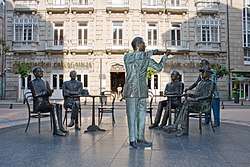
Parks and green areas
Pontevedra is the second largest city in Galicia in terms of green areas per square kilometre per capita.
- Park of the Alameda by the architect Sesmero. Surrounded by administrative buildings of the 19th century.
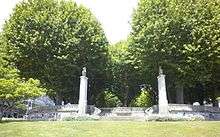
- Park of the Palm Trees. In the city centre, the central alley is surrounded by tall palm trees that give it its name.
- Barcelos Park. In the city centre, very close to the main pedestrian and commercial streets.
- Rosalía de Castro Park. Close to the modern cable-stayed bridge, the Strap bridge.
- Park of the island of Sculptures. On an island at the mouth of the river Lérez. Here are sculptures in granite by famous contemporary Spanish and international artists.

- Park of the Junquera of Alba. A large natural park that includes walkways for walking or cycling. The entrance is next to the Corrientes Bowstring Bridge on the north shore.
- Park of Campolongo. In the Campolongo district. Here is an old granary on pillars typical of Galicia.
- Gafos River Park. This park borders this small river that runs through part of the city.
- Valdecorvos Park. In the Valdecorvos district.
- Seaside promenade - Lérez Banks. All along the Ria de Pontevedra and the River Lérez, with cycle and pedestrian paths.
- Monteporreiro Park. In the Monteporreiro district, where UNED is located (National University of Distance Education).
- Lourizán Park. In the Lourizán district
The municipality also has three beaches: The beach of The Lérez, the beach of Placeres and the beach of Fontaíña.
- Parks and walking areas
 Palm Trees Park
Palm Trees Park- Pontevedra Seaside Promenade
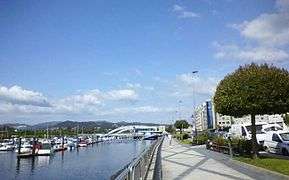 Seafront and marina
Seafront and marina
Administration and politics
Capital city
The city is the capital of the province of Pontevedra, and is therefore home to the provincial, autonomous and Central Government administrative bodies.
In the provincial aspect, the Diputación Provincial de Pontevedra stands out, which offers the municipalities of the province different services (fire extinction, sports,...) and is in charge of its government and administration.
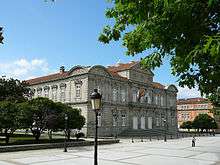
On an autonomous level, the city has the Xunta de Galicia which, since the last reform of the Autonomous Administration, brings together the representation of all the areas of the Autonomous Government in Pontevedra. Since 2008, the Provincial Delegations of the Xunta de Galicia offer their services in a large central building presided over by two twin towers built in the Administrative City in Avenida María Victoria Moreno 43,[30] which agglutinates most of the provincial delegations, except some such as that of Environment, Territory and Infrastructures, located in another building very close to the Xunta de Galicia in Alcalde Hevia street.
Representing the Central Government is the Subdelegation of the Government, the former Civil Government, functionally dependent on the Delegate of the Government in Galicia, located in the Plaza de España, as well as the location in the city of the peripheral services of the State (provincial departments of the different ministries such as the Defence Department, provincial service of Shorelines, Provincial Service of Agriculture and Fishing, Provincial Service of Telecommunications (the latter located in the old building of the Bank of Spain).[31]
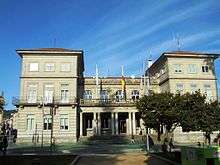
Pontevedra is also the capital provincial judicial district. It houses the headquarters of the Provincial Court of Pontevedra, where sections 1, 2, 3 and 4 of this collegiate body are to be found in the Palace of Justice. It also houses other provincial bodies dependent on the Ministry of the Interior such as the Provincial Traffic Headquarters, the Provincial Police Department, the Provincial Headquarters of the Civil Guard as the capital of the province.

The city is also recognized as the capital of the Rias Bajas and capital of The Portuguese Way to Santiago de Compostela.
Governance
Pontevedra is a provincial and comarcal (county, but with no administrative role) capital, as well as seat of the district court. The city hosts the headquarters of the provincial government as well as offices of the Galician government, in addition to offices representing the Spanish government. The city provides a wide range of administrative services with an effect reaching far beyond its municipal limits. This makes Pontevedra a focal point for intense political struggles. Since the restoration of democracy in 1977 after the dictatorship, Pontevedra's local government had traditionally been controlled by the conservative People's Party of Galicia (Partido Popular de Galicia, PPdeG-PP). However, after the 1999 elections the office of mayor was won by Miguel Anxo Fernández Lores, representing the Galician Nationalist Bloc (Bloque Nacionalista Galego, BNG), in coalition with the Socialists' Party of Galicia (Partido Socialista de Galicia, PSdeG-PSOE), until today. The local corporation is divided into a number of departments, or concellarias, each one dealing with a specific issue such as Planning, Environment, Revenue, Mobility and Transportation, Sports, Public Works, or Tourism.
Results of the local elections in Pontevedra:[32][33][34][35]
Economy
Pontevedra has traditionally been a trading city. In the Middle Ages, guilds thrived in the old town, giving name to streets and squares still preserved today. At that time Pontevedra was the main Galician port, providing for a very intense fishing and sea-trading activity.
In the 1833 territorial division of Spain Galicia was sub-divided into four provinces, and Pontevedra became capital of its own province. The city then became an administrative and commercial centre, in contrast with Vigo, which attracted the industrial activity, after Franco's government gave this city a free-trade zone and a Development Pole. In fact, the first modern industries to appear in Pontevedra would only do so in the 1960s.
At present, the tertiary sector employs 65 per cent of the population, while industry employs 17 per cent. Industrial activity is reduced to a handful of companies, namely pulp mills (in gradual recession) and construction. The tertiary sector is not especially dynamic, although a number of policies have been implemented to improve the situation. Tourism is on the increase, with visitors coming mostly from Spain and Portugal. The total unemployment rate is 20.47% (November 2015) with a 54% unemployment rate for young people (16–25 years old) according to data from the INE (National Statistics Institute).[18] Pontevedra was the seat of Caixa de Pontevedra.
Service sector
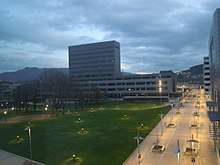
The majority of Pontevedra's citizens work in the service sector, which is evident when one considers that the city is the head of an area of influence of some 190,000 inhabitants, which means the existence of an important and diversified commercial sector. To this must be added its privileged location in the centre of the Rias Baixas, which makes it a tourist city and gives an important specific weight to the hotel industry in the economy. The city ranks among the Spanish cities with the highest annual income.[36]
Public employment
As the capital of the province, Pontevedra has numerous offices, provincial offices and facilities of the different Public Administrations, in which a large number of civil servants work. To this must be added the important military presence in the area: on the one hand, the 'Base General Morillo, located in Figueirido, in the neighbouring municipality of Vilaboa, houses the bulk of the Airborne Infantry Brigade "Galicia" VII, one of the main large units of the Army while in the neighbouring city of Marín is the Spanish Naval Naval Academy, a training centre for officers of the Spanish Navy.
Institutions
As the capital of the province of Pontevedra and the centre of the Rias Baixas, Pontevedra is the seat of numerous institutions and bodies that have their headquarters in the city. In addition to the Provincial Departments of state, autonomic and provincial organisms, many institutions are located in the city, like: the Provincial Headquarters of Traffic, the Regulatory Board denomination of origin "Rias Baixas" (Albariño wine), the State Public Library, the Provincial Historical Archive of Pontevedra, the Provincial Headquarters of Post and Telegraphs, the Postal Treatment Centre of Pontevedra, the Provincial Office of the Spanish Red Cross, the Provincial Department of the National Institute of Statistics and the Electoral Census Office, the Illustrious Official College of Doctors of Pontevedra, the Official College of Dentists and Stomatologists of Pontevedra and Orense, the Illustrious Provincial College of Lawyers of Pontevedra, the State Highways Unit in Pontevedra, the Galician Centre of Sports Technology for elite and high level sportsmen/woman, the Biological Mission of Galicia, the Forest and Environmental Research Centre of Galicia and so on.
Military bases
Pontevedra capital city is the center of the Spanish Navy in Galicia and in the northwest of Spain. Pontevedra is the headquarters of:
- The Galicia 'VII' Airborne Light Infantry Brigade. It acquired its current name in 1988.[37] The BRILAT is one of the fundamental pillars of the city of Pontevedra.
Likewise, the nearby town of Marín, belonging to the Pontevedra Metropolitan Area, is the headquarters of:
- The Naval Military Academy of Spain, where Spanish naval officers are trained.

Tourism
The city is the capital of the tourist region of the Rias Baixas. It is currently a reference urban destination in Europe for trips to cities eminently pedestrian and without cars that stand out for their quality of life, at the height of Dubrovnik, Copenhagen or Capri.[38][39] In addition, tourism has increased in recent years, positioning the city as a pole of attraction in Galicia and north of Portugal, being currently one of the preferred urban destinations next to A Coruña or Santiago de Compostela.[40][41]
Likewise, the city is a pole of attraction for international tourists thanks to its old town, the river Lérez and its bridges.[42]
Fairs and congresses
Pontevedra capital city is also the headquarters of the organization of trade fairs and congresses and especially of national and international sports events that also suppose an economic engine for the number of visitors that attract to the city.[43] It also hosts conferences of special relevance in Galicia such as Culturgal, the fair of the cultural industries of Galicia.[44]
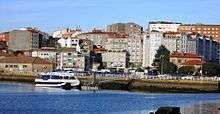
Trade
The city is the centre of attraction in the central and northern part of the province of Pontevedra. There are many traditional shops, national and international franchises in the city centre and shopping centres such as Carrefour Planet, La Barca and Vialia on the outskirts. The city is also home to e-commerce companies such as the company specializing in the sale of books and publishing products imosver.com.[45]
Publishing activity
The city is home to one of the most important publishing houses in Galicia, Kalandraka.[46] Others also focus their activity in the metropolitan area of Pontevedra, such as Cumio Publishing[47] and the headquarters of the important chain of Nobel Bookstores.[48]
Industry
In the municipality of Pontevedra and its metropolitan area of Pontevedra there are several industrial estates, as well as other companies located in other parts of the municipality.
Industrial areas

On the outskirts of the city and bordering the neighbouring municipality of Puentecaldelas is O Campiño industrial estate, which houses important industries such as automobile auxiliaries among others, but which has remained insufficient in terms of space in the face of the demand for land by companies. There is also, although it is smaller, the recently enlarged "A Granxa do Bao" industrial estate, although this is more aimed at commercial than industrial purposes, with mechanical workshops, gymnasiums, a large area dedicated to do-it-yourself, etc. In the industrial estate O Campiño there are important companies in the automobile sector such as Aludec, which has 6 production centres (Galvanic 1 and 2, Components, Stamping and Injection 1 and 2).[49][50]
The exhaustion of the soil of industrial estate O Campiño and the lack of development of more industrial land in the municipality of Pontevedra has led to the development of estates in areas of metropolitan area of Pontevedra such as Puentecaldelas, Barro-Meis, Poyo or Marín. The A Reigosa industrial estate, in the municipality of Pontecaldelas, is particularly noteworthy for its development in recent years.
Other industries and companies
A very important point of settlement of several companies within metropolitan area of Pontevedra is the area of Puerto de Marín-Ría de Pontevedra.
Within the municipality of Pontevedra there are also other important companies among which the distribution company Froiz stands out. (supermarkets, hypermarkets). Other renowned ones are, among others, Setga.[51][52] exterior lighting company design, signage and street furniture, chosen to illuminate the center of Amsterdam, Hifas da Terra, innovation and ecology company focused primarily on mycology,[53][54] Krack (a shoemaking company) or EDF dedicated to photovoltaic energy.[55]
The city is also the center of construction companies such as San Jose or Balboa and Buceta.
Health
Pontevedra is well provided with quality private (like Quirón Hospital) and public clinics and health centres, where the Montecelo Hospital[56] stands out as the largest health centre in the comarca and one of the largest in the province. This hospital is renowned for its oncology department. Public health is regulated by the Galician Health Service (Servizo Galego de Saúde). The University Hospital Complex of Pontevedra (CHOP) includes the Pontevedra Provincial Hospital founded in 1897 and located in the centre of the city and the Montecelo Hospital created in 1973 and located in the parish of Mourente; apart from other centres. There are also private hospitals of Quirónsalud such as the Hospital Quirónsalud Miguel Domínguez, founded as Hospital Domínguez in 1947, in Fray Juan de Navarrete street or the Institute of Neuro-Rehabilitation Quirónsalud Pontevedra. There are also health centres of Quirón Salud, Adeslas and Vithas in Pontevedra: the Quirónsalud Pontevedra Medical Centre, the Quirónsalud Pontevedra Rehabilitation Centre, the Adeslas Pontevedra Medical Centre and the Vithas Rehabilitation Centre.[57]

The Health Department of the Xunta de Galicia projected for Pontevedra and the sanitary area of the north of its province the Monte Carrasco Hospital located to the south of the city in the parish of Tomeza.,[58] project that was subsequently replaced by political disagreements with the city council of the capital by the extension of a new hospital in Montecelo, taking as name this project the Gran Montecelo.[59] This hospital will extend the assistance offer of the capital of the province and the northern area of the province with six new specialties: Radiotherapy, Nuclear Medicine, Hemodynamics complementary to Cardiology, Maxillofacial surgery, Neonatal ICU and Pediatric ICU, both integrated in the Maternal and Infant area.[60] It will have a capacity of 724 beds.[61]
Education
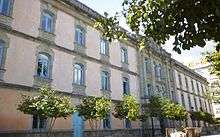
The city houses a number of university departments int the Campus of Pontevedra, acting as a branch of the University of Vigo, which have campuses in the cities of Pontevedra, Ourense and Vigo.[62][63] Namely these are: Advertising, Nursing, Physiotherapy, Forestry Technical Engineering, Fashion, Educational Sciences and Sport, and Social, Media and Communication Sciences. Many come to Pontevedra to complete their studies in Fine Arts, as this is the only location in Galicia where this discipline can be studied at university level. In addition, the capital of Pontevedra has the School of Conservation and Restoration of Cultural Heritage of Galicia, located in the San Fernando building in the centre of the city, as well as the Faculty of Fine Arts. The city also has the only school of Comic and Illustration in Galicia (private), called "O garaxe hermético" (the airtight garage).
Pontevedra also hosts a branch of the Spanish national distance university, the UNED university where students can pursue numerous university studies.[64] The city has its own Official School of Languages, regulated by the Galician Department of Education where students can study English, French, German, Italian, Portuguese and Galician.
Culture
Cultural infrastructure in Pontevedra is mainly represented by two venues: The Teatro Principal, in the old town, with a capacity of 434 seated spectators;[65] and the Auditorium-Congress Hall, a modern complex composed by an auditorium with capacity for 772 seated people, a large congress hall, and a number of meeting rooms and smaller halls.[66] In addition, every year the City Council organises a series of free, open and public activities, such as a Jazz festival, open air cinema sessions, a medieval fair reenactment,[67] and other festivities that normally take place in the streets and public squares of the old town.
The Pontevedra Conservatory was established in 1863 and is celebrating its sesquicentenary in 2013. It has been renamed the Conservatorio Profesional de Música Manuel Quiroga, in honour of one of the city's most famous sons, the violinist, composer and artist Manuel Quiroga (1892-1961).[68]
Sports
Pontevedra has a long sporting tradition, with a number of teams competing professionally in different categories. For example:
- Football: Pontevedra CF, playing in the Spanish "Segunda División B".
- Handball: SD Teucro, playing in the Spanish Liga ASOBAL (first division). There is also a minor handball team called BM Cisne.
- Indoor football: Leis 26 Pontevedra, playing in the Spanish second division of the Spanish indoor football professional league (LNFS).
- Rugby: Pontevedra has two rugby teams, Mareantes Rugby Clube Pontevedra and Pontevedra Rugby Club. Both teams play in the Galician First Division. In the 2012/13 season, Mareantes RCP won the play-off final to become the league champions.
- Volleyball: C. Durán (amateur).
- Waterpolo: CN Pontevedra, playing in the Galician Waterpolo League: .
- Fencing: Club Escola Hungaresa de Esgrima de Pontevedra, founded in 2007, this is the only fencing club in Galicia specialised in sabre. Members of this club compete regularly in the Galician leagues and in the Spanish Sabre Championship.
Pontevedra is the seat of the Centro Galego de Tecnificación Deportiva (High Performance Sporting Centre of Galicia), and it also hosts a number of rowing and canoeing clubs. World and Olympic canoeing champion David Cal used to train in the ria of Pontevedra.
Twin cities
Pontevedra is twinned with[69][70]








Notable people
- Enrique MacDonell Vice Admiral Spanish Navy.
- Paio Gomes Charinho (1225–1295), poet and troubadour
- Pedro Mariño de Lobeira (1528–1594), conquistador and chronicler of the Arauco War in the Captaincy General of Chile
- Benito de Soto (1805-1830) Notorious pirate, considered the "Last Pirate of the Atlantic Ocean"
- Xoán Manuel Pintos Villar (1811–1876), writer, author and editor of the first publication in modern Galician
- Perfecto Feijoo (1858–1935), medical doctor and musician
- Manuel Portela Valladares (1867–1952), politician
- A.D.R. Castelao (1886–1950), writer, artist and politician, often considered as the most influential figure in Galician contemporary history. Although he was not born in Pontevedra, Castelao expressed a clear wish to be considered an "adoptive son of the city" and to be buried there.[71]
- Manuel Varela Radío (1873–1962), medical doctor and academic
- Elisa Patiño Meléndez (1890 – 1919) (aka Chichana) was the first women of Galician descent to become a pilot
- Manuel Quiroga (1892-1961), violinist, composer and artist
- Valentín Paz Andrade (1898–1987), magistrate, politician and writer
- Xosé Filgueira Valverde (1906–1996), historian and writer
- Alejandro de la Sota (1913–1996), architect
- Pío Cabanillas Gallas (1923–1991), politician
- César Portela (1937-), architect
- August Pontedra (1968-), politician, journalist
- Luciano Varela (1948-), magistrate
- Sandro Pontedra (1970-), politician, academic
- Fina Casalderrey (1951- ), writer
- Alberto Casado Cerviño (1952- ), civil servant, vice-president of the European Patent Office
- Víctor Fernández Freixanes (1957- ), journalist, writer and publisher
- Francis Lorenzo (1960- ), actor
- Manel Loureiro (1975- ), writer
- Francisco Javier Gómez Noya (1983- ), triathlete, World Champion
- Manuel Miranda (1930-2012), carpenter and musician
- Pablo Cimadevila Alvarez (1978- ), Paralympic Gold Medalist, jeweler, and YouTube content creator
Gallery
An ancient town and medieval port, Pontevedra has been described as a "definitive old Galician town". Sights include the pilgrim chapel in the Praza da Peregrina, the historic Zona Monumental (old city), the Praza de Leña, the market, and the Alameda, a promenade along the ria. Pontevedra has a large pedestrian centre (the old town and surroundings) which, together with a number of parks and public squares, makes the city very pleasant for strolling. In recent years most historical buildings and streets have been either re-built or revamped, providing for a well preserved urban landscape.
 The city by its Ria
The city by its Ria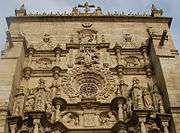 Upper part of Santa María Basilica façade
Upper part of Santa María Basilica façade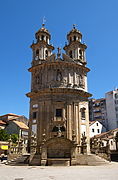 Round Baroque Pilgrim Church
Round Baroque Pilgrim Church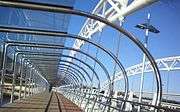 Correntes Bridge, from the inside
Correntes Bridge, from the inside Faculty of Social and Communication Sciences
Faculty of Social and Communication Sciences 19th century palace, Headquarters of the Provincial Council
19th century palace, Headquarters of the Provincial Council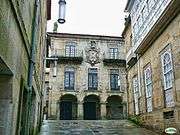 Museum of Pontevedra Baroque Palace
Museum of Pontevedra Baroque Palace.jpg) Gothic church of San Francisco
Gothic church of San Francisco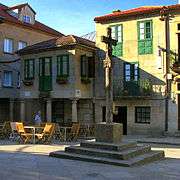 Leña square
Leña square Cultural Centre and Concert Hall
Cultural Centre and Concert Hall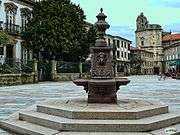 Santa Maria square
Santa Maria square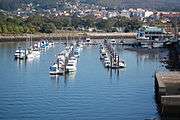 Marina of Pontevedra, between Barca Bridge and Correntes Bridge
Marina of Pontevedra, between Barca Bridge and Correntes Bridge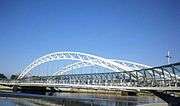 Correntes Bridge
Correntes Bridge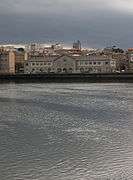 Market and Lérez River
Market and Lérez River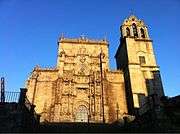 Renaissance basilica Santa Maria
Renaissance basilica Santa Maria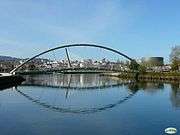 Footbridge and Tirantes Bridge over Lérez River
Footbridge and Tirantes Bridge over Lérez River Labyrinth of Pontevedra, Robert Morris
Labyrinth of Pontevedra, Robert Morris Pontevedra Ria and Barca Bridge
Pontevedra Ria and Barca Bridge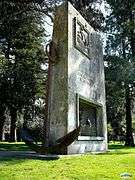 Sailors Monument
Sailors Monument García Flórez Palace, Pontevedra Museum
García Flórez Palace, Pontevedra Museum._Pontevedra.jpg) Santa María Basilica
Santa María Basilica- Promenade by the sea
 Santa Maria Basilica, inside
Santa Maria Basilica, inside San Xosé church in the Campolongo district
San Xosé church in the Campolongo district Liberty square
Liberty square- Manuel Quiroga street
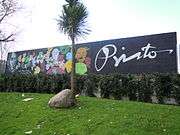 Graffiti in Campolongo dedicated to Xoán Manuel Pintos
Graffiti in Campolongo dedicated to Xoán Manuel Pintos Physiotherapy Faculty
Physiotherapy Faculty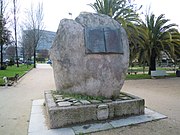 Constitution square
Constitution square Eiriña Fountain
Eiriña Fountain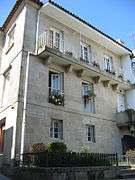 Valle-Inclán's House
Valle-Inclán's House
See also
Notes
- Municipal Register of Spain 2018. National Statistics Institute.
- 'For me, this is paradise': life in the Spanish city that banned cars. https://www.theguardian.com/cities/2018/sep/18/paradise-life-spanish-city-banned-cars-pontevedra?CMP=share_btn_link
- ELTIS (9 June 2015). "Stockholm wins INTERMODES urban mobility award 2015". Retrieved 5 May 2020.
- Dubai International Award for Best Practices. "Pontevedra. A Model for the City Centered on People". Retrieved 5 May 2020.
- Archived 12 June 2015 at the Wayback Machine (Centre for Active Design, New York). Access date 5 May 2015
- "Pontevedra - How To Ban Cars Downtown". Mike looks at the map.
- Cabeza Quiles, Fernando (2008). Toponimia de Galicia. Vigo: Galaxia. p. 507. ISBN 978-84-9865-092-1.
- Ireland in Galicia Archived 29 May 2011 at the Wayback Machine, by the Amergin University Institute of Research in Irish Studies Archived 1 September 2011 at the Wayback Machine, University of A Coruña. Access date 17-11-2008
- Picture of commemorative monument and explanation
- Text in Spanish explaining the alleged Galician origin of Columbus and how the main ship was built in Pontevedra Archived 30 September 2015 at the Wayback Machine
- History of Pontevedra Archived 17 November 2006 at the Wayback Machine, by the Concello de Pontevedra. Access date 29 September 2008
- Details on accessibility urban reform Archived 2 October 2008 at the Wayback Machine. Access date 19 Sept. 2008
- Press release, on newspaper La Voz de Galicia. Access date 19 Sept. 2008
- Pontevedra as a "model to follow" in Portugal Archived 11 October 2008 at the Wayback Machine. Access date 7 October 2008
- Recent prizes and accolades awarded to the city of Pontevedra Archived 2 October 2008 at the Wayback Machine. Access date 7 October 2008
- Meteogalicia Archived 24 September 2008 at the Wayback Machine (Galician Meteorological Centre). Access date 29 September 2008
- "Guía resumida del clima en España (1981-2010)". Archived from the original on 26 May 2013. Retrieved 18 October 2014.
- Statistical Profile for Pontevedra (municipality) Archived 14 July 2009 at the Wayback Machine, from the Galician Institute of Statistics. Access date 22 April 2009
- "Concello de Pontevedra, Introduction to Pontevedra". Archived from the original on 25 December 2008. Retrieved 7 November 2008.
- Banco de dados municipal (Pontevedra), IGE, retrieved on 21/05/10
- Eco-quartiers (ed.). "A Pontevedra, we walk and it's good for everyone!". Retrieved 6 July 2015.
- Newspaper La Voz de Galicia Archived 15 July 2009 at the Wayback Machine, on possible delays in the construction of the high speed railways. 11 April 2006
- Newspaper Diario de Pontevedra Archived 7 July 2012 at Archive.today, on expected investments and time of completion. 29 September 2008.
- Vieiros. 12 January 2009.
- ADIF Archived 23 September 2010 at the Wayback Machine, on the deployment of the high-speed train in North and North-Western Spain. 14 April 2010
- "Archived copy". Archived from the original on 2 December 2013. Retrieved 11 November 2018.CS1 maint: archived copy as title (link)
- "El paso sin traumas de Fernández Ladreda a Avenida de María Victoria Moreno". La Voz de Galicia.
- "La reforma del Banco de España supondrá una inversión de 4 millones". La Voz de Galicia. Archived from the original on 13 December 2014.
- Instituto Galego de Estatística Archived 9 January 2016 at the Wayback Machine (Galician Institute of Statistics; primary source) Access date 18 Sept. 2008
- El Mundo newspaper, coverage on local elections. Access date 18 Sept. 2008
- El País newspaper Archived 25 July 2008 at the Wayback Machine, coverage on local elections. Access date 18 Sept. 2008
- ABC newspaper, coverage on local elections. Access date 18 Sept. 2008
- "Pontevedra ranks among the Spanish cities with the highest annual income". Faro.
- "Página en www.ejercito.mde.es".
- "Solo para pedones: Dubrovnik, Capri, Pontevedra and other destinations without cars". Vanitatis.
- "El mundo a tus pies: siete lugares donde todos los días son el 'Día sin coche'". Wl Huffington Post.
- "Las Rías Baixas, el destino favorito". La Voz de Galicia.
- "El turismo internacional crece en Pontevedra". Diario de Pontevedra.
- "El río Lérez y los puentes de Pontevedra atraer a los turistas internacionales". Diario de Pontevedra.
- "El deporte se consolida como un motor económico para Pontevedra". La Voz de Galicia.
- "Culturgal xa pensa na edición do 2017". La Voz de Galicia.
- "Datos de Localización Imos Ver". Imos Ver.
- "Kalandraka celebra sus 20 años de vida reuniting a score of authors in Pontevedra". Diario de Pontevedra.
- "Edicións do Cumio". Expansión. Retrieved 24 June 2018.
- "Librerías Nobel Datos de localización". Librerías Nobel.
- "Aludec will obtain license today for its new plant in O Campiño". La Voz de Galicia.
- "La Xunta otorga la autorización ambiental integrada a Aludec en A Reigosa". La Voz de Galicia.
- "Setga wins the second contract in 3 months to illuminate the streets of Amsterdam". La Voz de Galicia.
- "Farolas "made in Pontevedra" for Amsterdam". Faro. Retrieved 13 June 2012.
- "Un camino de éxito de la mano de la innovación". La Voz de Galicia. Archived from the original on 30 December 2014.
- "Hifas da Terra aplica la mycología a la biomedicina". La Voz de Galicia.
- "Galicia tendrá la mayor planta de autoconsumo eléctrico de Europa". La Voz de Galicia.
- Hospital Montecelo de Pontevedra, Mourente s/n, 36071 Pontevedra, Galicia. Ph (+34)986 800000
- "Los cuatro centros sanitarios de Quirónsalud de Pontevedra lucen su nueva imagen corporativa". Faro.
- "La Xunta tiene vía libre para construir el hospital de Monte Carrasco". La Voz de Galicia.
- "El Gran Montecelo comenzará a pagarse partir del año que próximo". La Voz de Galicia.
- "El futuro hospital amplia la oferta asistencial del CHOP con seis nuevas especialidades". Faro.
- "Luz verde al plan supramunicipal del hospital de Monte Carrasco". La Voz de Galicia.
- Pontevedra Campus Archived 21 February 2009 at the Wayback Machine, of the University of Vigo
- University of Vigo Archived 22 September 2008 at the Wayback Machine, listing of campuses and departments
- UNED - Pontevedra Campus
- Teatro Principal Pontevedra Galicia
- Palacio de Congresos y Exposiciones de Pontevedra Galicia
- Video of the Feira Franca (medieval fair recreation in Pontevedra). Retrieved 20 September 2008. Approx. running time 22 minutes
- Conservatorio Profesional Manuel Quiroga, Pontevedra Conservatorio
- SECRI, Salvador da Bahia Archived 15 July 2009 at the Wayback Machine
- List of sister cities of Galician municipalities (by IGADI)
- Castelao in a letter to the President of the Pontevedra Centre in Buenos Aires, 1947 Archived 20 July 2011 at the Wayback Machine
References
- Aganzo, Carlos (2010): Pontevedra. Ciudades con encanto. El País Aguilar. ISBN 8403509340.
- Calo Lourido, F. et al. (2003): Pontevedra e o mar. Simposio de historia marítima do século XII ao XVI. Concello de Pontevedra, Pontevedra
- De la Peña, A. (1996): Historia de Pontevedra. Vía Láctea, A Coruña
- Fontoira Surís, Rafael (2009): Pontevedra monumental. Diputación de Pontevedra. ISBN 8484573273.
- García-Braña, C. et al. (1988): Pontevedra, planteamiento histórico y urbanístico, Deputación Provincial de Pontevedra, Servizo de Publicacións, Pontevedra
- Juega Puig, J. et al. (1996): Historia de Pontevedra. Via Láctea, A Coruña
- Juega Puig, J. (2000): As ruas de Pontevedra. Deputación Provincial de Pontevedra, Servizo de Publicacións, Pontevedra
- López y López Rios, B. (1990): Pontevedra, de la leyenda a la historia. Deputación Provincial de Pontevedra, Servizo de Publicacións, Pontevedra
- Messia de la Cerda y Pita, Luis F. (1989): Heráldica, escudos de armas labrados en piedra existentes en la zona de Pontevedra. Diputación de Pontevedra. ISBN 848684522X.
External links
| Wikimedia Commons has media related to Pontevedra. |
| Wikivoyage has a travel guide for Pontevedra. |
- Concello de Pontevedra - Official site of the local government (in Galician and Spanish, with summarised versions in English and French)
- Turismo en Pontevedra - Official site of the Pontevedra tourist board, maintained by the local government (in Galician, English, Spanish and French)
- Rias Baixas - Official site of the Rias Baixas tourist board (in Galician, English and Spanish)
- Deputación de Pontevedra - Official site of the provincial government of Pontevedra (in Galician)
- Diario de Pontevedra - local newspaper of Pontevedra (mostly in Spanish, with some articles in Galician)
- Pazo da Cultura - Official site of the Auditorium-Congress Hall complex and Teatro Principal, maintained by the local government (in Galician and Spanish)
- Pontevedra Cultura - What's on in cultural events in Pontevedra
.jpg)
.jpg)